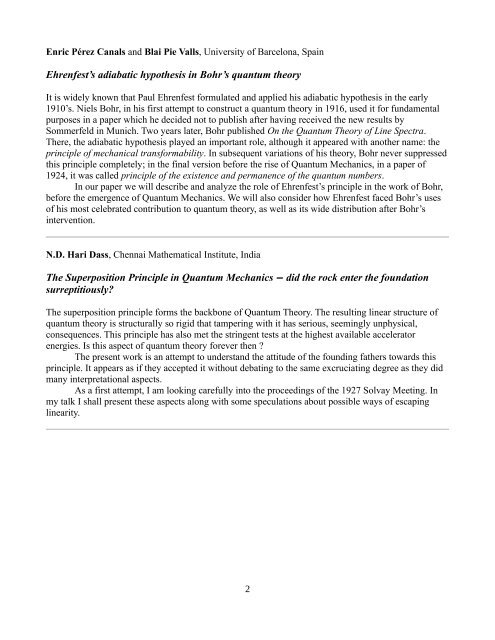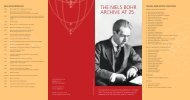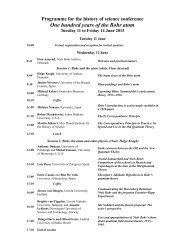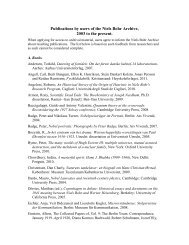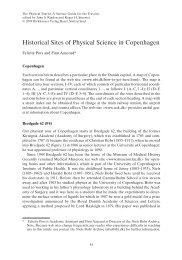Love and physics: Margrethe Nørlund and Niels Bohr's creativity ...
Love and physics: Margrethe Nørlund and Niels Bohr's creativity ...
Love and physics: Margrethe Nørlund and Niels Bohr's creativity ...
Create successful ePaper yourself
Turn your PDF publications into a flip-book with our unique Google optimized e-Paper software.
Enric Pérez Canals <strong>and</strong> Blai Pie Valls, University of Barcelona, Spain<br />
Ehrenfest’s adiabatic hypothesis in Bohr’s quantum theory<br />
It is widely known that Paul Ehrenfest formulated <strong>and</strong> applied his adiabatic hypothesis in the early<br />
1910’s. <strong>Niels</strong> Bohr, in his first attempt to construct a quantum theory in 1916, used it for fundamental<br />
purposes in a paper which he decided not to publish after having received the new results by<br />
Sommerfeld in Munich. Two years later, Bohr published On the Quantum Theory of Line Spectra.<br />
There, the adiabatic hypothesis played an important role, although it appeared with another name: the<br />
principle of mechanical transformability. In subsequent variations of his theory, Bohr never suppressed<br />
this principle completely; in the final version before the rise of Quantum Mechanics, in a paper of<br />
1924, it was called principle of the existence <strong>and</strong> permanence of the quantum numbers.<br />
In our paper we will describe <strong>and</strong> analyze the role of Ehrenfest’s principle in the work of Bohr,<br />
before the emergence of Quantum Mechanics. We will also consider how Ehrenfest faced Bohr’s uses<br />
of his most celebrated contribution to quantum theory, as well as its wide distribution after Bohr’s<br />
intervention.<br />
N.D. Hari Dass, Chennai Mathematical Institute, India<br />
The Superposition Principle in Quantum Mechanics ‒ did the rock enter the foundation<br />
surreptitiously?<br />
The superposition principle forms the backbone of Quantum Theory. The resulting linear structure of<br />
quantum theory is structurally so rigid that tampering with it has serious, seemingly unphysical,<br />
consequences. This principle has also met the stringent tests at the highest available accelerator<br />
energies. Is this aspect of quantum theory forever then ?<br />
The present work is an attempt to underst<strong>and</strong> the attitude of the founding fathers towards this<br />
principle. It appears as if they accepted it without debating to the same excruciating degree as they did<br />
many interpretational aspects.<br />
As a first attempt, I am looking carefully into the proceedings of the 1927 Solvay Meeting. In<br />
my talk I shall present these aspects along with some speculations about possible ways of escaping<br />
linearity.<br />
2


